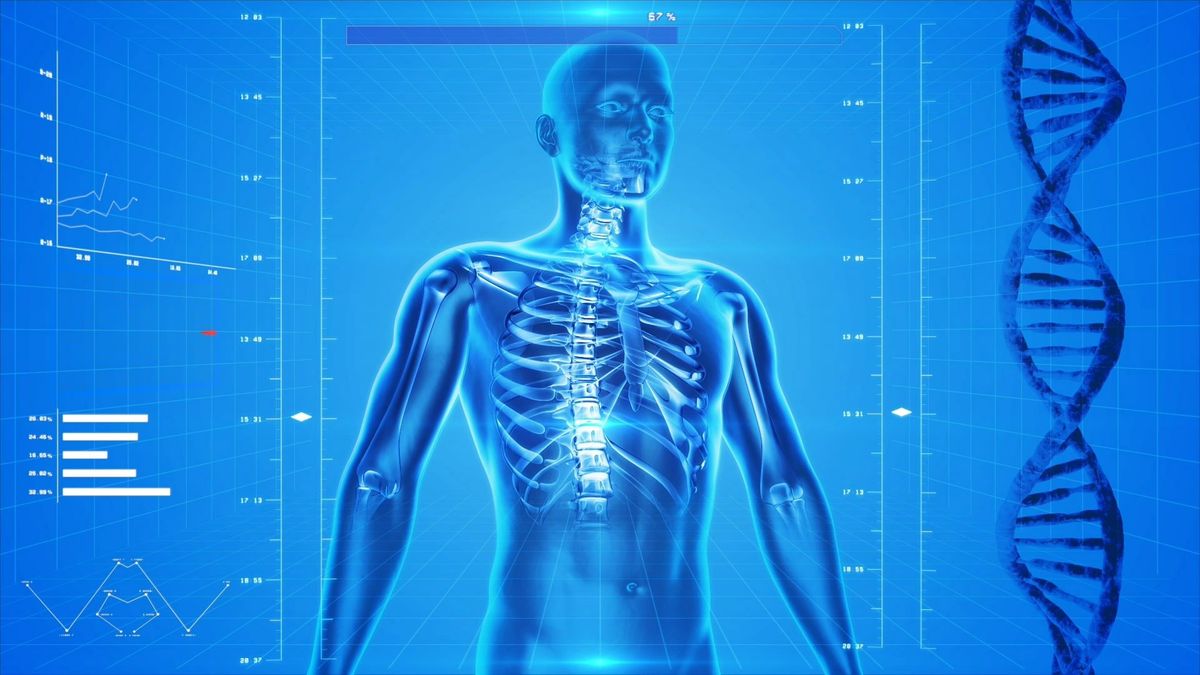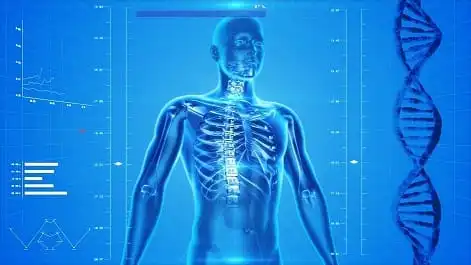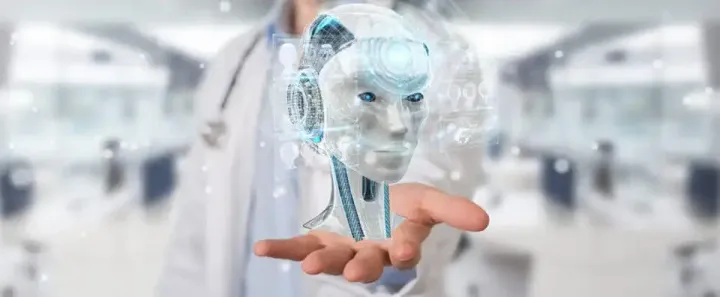Artificial Intelligence and Robotics are Transforming the Healthcare Industry
AI is transforming the medical industry from patient care to drug discovery methodologies. The potential of AI and robotic in the human healthcare eco-system has no limits. AI simplifies patients' and physicians' complexities by performing tasks with exceptional capabilities in less time and cost.

Artificial intelligence is becoming an expert at doing what humans can do with high proficiency, affordability, and quick response rate. The potential of AI and robotic in healthcare has no limits; both increase their impact on the human healthcare eco-system. AI simplifies patients, specialists, and clinic administrators' complexities by performing tasks with exceptional capabilities in less time and expense of less money. The AI sector is one of the biggest industries grown at $600 million in 2014 and predicted to cross $150 billion in 2026.
Unlike other sectors, the Healthcare industry is a multi-field discipline that includes a variety of dealings; traditional medicines, doctors, patients, diseases, systematic issues, behaviors, and medical professionals. It is not easy to bring innovation or develop technologies for dealing with the given facts. According to Statista, the market of AI and robotics in healthcare will lead from one billion to over twenty-eight billion U.S. dollars.
Introduction to AI in the Healthcare Industry
AI can transform the medical industry from patient care to the development of drug discovery methodologies. The great application of AI is in detecting breast cancer in females at a higher rate than 11 pathologists, thus preventing its further spread. The big tech firms like Google are starting their new AI-based projects to develop prediction models. These will alert doctors about risky situations before the time, such as heart failure or brain hemorrhage. Enlitic and Google are developing AI-powered image interpretation algorithms to search for a particular disease with an image.
Moreover, Jvion’s clinical success machine tells about the patients' condition, survival chances, and how much time they require to be fit again. These techniques will help clinicians to make decisions about efficient treatment and its dose after disease diagnosis.
Machine Learning
It's a sub-branch of AI that provides the system with learning and improving results from experience. There are, however, three significant types of machine learning (ML):
- Unsupervised Learning
- Supervised Learning
- Reinforced Learning
Predictive medicine is the most prominent application of machine learning in the healthcare industry. It uses previous traits, history, and different treatment protocols to determine specific treatment for a patient. The supervised learning model requires a training database for predictive medicine applications. Detection of faults in radiology images is a common application of neural networks and deep learning algorithms. It will allow radiologists to focus on other important tasks.
AI and Robotics Applications in Healthcare
AI and robotics are filling the gap by making advances in the healthcare industry. The scope of AI in the healthcare sector has no boundaries as it used to offer several outstanding treatments as:
- Discover links genetic codes
- Develop surgical (surgery-assisting) robots
- Maximize the hospital's efficiency
- Cancer research and data management
- Detecting skincare via the mobile application
AI is reinventing ways to modernize the healthcare industry via machines capable of learning, adapting, and acting correctly. It allows health tracking remotely by offering facial and vocal interactions. In 1985, the researchers planned to introduce AI in healthcare for improving precision in surgery and other complex operations. The performance of DaVinci Robot (launched in the year 2000) shows the technical development and improvement in its functioning.
But many experts believe that AI and robotics cannot replace humans in treating patients completely because they can't be close to the patients. It doesn't matter how impressive the AI technique is in healthcare, but it's still in human control. AI's real achievement in the 21st century is the robo-doctor that comes with an advanced artificial intelligence system; it learns the doctor's behavior to outperform the available knowledge task. Hence, AI cannot replace humans but can make the medical staff more trained and efficient. It helped in improving several areas, including:
A. Improving the Accuracy
Robots are not humans; so, they don’t feel emotionally down and don’t get tired of their duty. Multiple robots are helping the healthcare industry as perfect surgeons in top hospitals globally. Called Waldo Surgeons have overcome the distance between machines and humans to perform the task with high accuracy and enhanced reliability. However, the researchers developed this software with the correct set of instructions and procedures; human assistance plays the secondary role of supervision. The engineers also developed micro-robots that precisely find their target and organize drugs. Plus, they can do micro-surgery like unblocking clogged blood vessels.
B. Reduced Errors in Disease Diagnosis
The right application of artificial intelligence in healthcare involves detecting patterns by learning various patient data records. The machines can scan complex multiple cases and correlate several variables (some are not even available in recent medical stations). Studies have shown that these robotic schemes can compete with the best physicians and even cross their intelligence in certain medical departments. For instance, a Japanese endoscopic system is excellent at detecting cancer with 86 percent accuracy in real-time. IBM Watson System already crossed 99 percent accuracy in diagnosing cancer among patients.
10 percent of US deaths occurred due to misdiagnosis and medication errors in 2015. Hence, there was a great need for a reliable diagnostic process, and AI is an extraordinary solution. It can predict disorders at a faster rate with high accuracy than medical specialists.
Here are six unique ways AI is helping to reduce errors and save lives:
1) PathAI
Location: Cambridge, Massachusetts
Purpose: Accurate AI-supported cancer diagnosis
Working: It's a machine learning program that helps pathologists for accurate cancer diagnosis. The organization focuses on reducing machine errors in diagnosis and developing new ways for customized medical treatment. It will help to deal with every patient independently.
Further, it worked with Bristol-Myers Squibb (drug developers) and other organizations like the Bill & Melinda Gates Foundation. These helping hands will help in boosting their exposure as AI technology in healthcare.
2) Buoy Health
Location: Boston, Massachusetts
Purpose: AI-based symptom and cure checker
Working: It comes with algorithms for detecting and treating illness. Here, a chatbot listens to what a patient feels during an illness and then suggest the correct cure based on the symptoms. Harvard Medical School uses this technology to diagnose and treat patients quickly with AI.
3) Freenome
Location: San Francisco, California
Purpose: AI-powered initial stage cancer detection
Working: It uses an AI system in scanning, diagnosis, and blood testing for cancerous cells. Freenome is committed to detecting cancer at earlier stages to apply subsequent cure treatments.
4) Enlitic
Location: San Francisco, California
Purpose: Deep learning for valuable insights
Working: It uses deep learning medical tools to assist the radiology department. It analyses random medical data, including blood tests, images, genomics, and patent previous medical history. Thus, helping doctors to share insights about the dare needs of a patient in real-time.
Enlitic is at the fifth number in advanced artificial intelligent systems above Facebook and Microsoft globally, according to MIT.
5) Beth Israel Deaconess Medical Center
Location: Boston, Massachusetts
Purpose: Diagnose blood disorders faster
Working: The given center is a part of Harvard University Teaching Hospital that uses AI for diagnosing deadly blood diseases. It helps in early-stage diagnosis; the clinicians use AI-powered microscopes to scan for bacteria in blood like E. coli and Staphylococcus. It identifies the presence of any bacterium in blood at a faster rate than old traditional methods. The researchers used 25,000 blood sample images to enable machine on how to detect a particular bacterium. Thus, the machine learns to identify bacterial species in blood with over 95 percent accuracy.
6) Zebra Medical Vision
Location: Shefayim, Israel
Purpose: AI-supported radiology assistant
Working: It is an AI-based radiology system that analyses scanned images for several clinical operations automatically. Then the radiologists use these findings for further analysis and diagnosis of a particular disease.
C. Remote Treatment and Discovering New Medicines
The idea of robotic use for remote treatment was first introduced in 1990 by DARP. But the network was unable to offer the required care to treat armed forces during the war. DARPA is putting efforts into offering excellent robotic surgery services, but still, it requires human assistance for hygienic purposes. It's a tough task that requires a big investment and not feasible economically. The U.S. Department of Defense Funded Research at Carnegie Mellon University & the University of Pittsburgh created an outstanding Robotic Trauma Care System to treat injured soldiers in different territories.
The trial of each drug requires $2.6 billion and only 10% of them passed to the market. With the growing impact of AI in healthcare, bio-pharmaceutical companies are introducing it in their system. The biggest AI breakthrough was observed in 207 with the discovery of the Adam robot for yeast research. Adam has billions of datasets in the public database about the function of 19 unique genes in yeast. Hence, it predicted 9 new and authentic hypotheses about genes functioning in yeast. Triclosan is an important ingredient found in toothpaste; Eve predicted that it could fight malaria-causing parasites.
A simple Bot-pill is another application of AI and robotics in healthcare. It aims to perform endoscopy in a convenient way that’s preferable over other methods. That amazing pill travels via the body to illuminate the intestine and leaves the body naturally.
AI with augmented reality (AR) capabilities help surgeons in providing customized overlays during an operation. The system highlights blood vessels and sensitive surrounding body areas to avoid any life-threatening mistake. The knowledge library also suggests the best tools to perform a particular surgery if a robotic arm is used.
The given six companies are using AI-programs to establish new ways for medicine discovery:
1) Bioxcel Therapeutics
Location: New Haven, Connecticut
Purpose: AI in the development of a biopharmaceutics
Working: BioXcel Therapeutics is an expert at dealing with immune-oncology and neurosciences. It developed an AI system to identify and prepare advanced medicines in the given fields. Plus, the company uses re-innovative programs to find unique applications for existing drugs and to identify patients. It was once named the "Most Innovative Healthcare AI Developments of 2019."
2) BERG Health
Location: Framingham, Massachusetts
Purpose: Using AI to treat rare diseases
Working: The physicians at BERG was working on Parkinson’s disease and recently published their study. It's an AI-based, clinical biotech platform that works on diseases to develop breakthrough medicines. They combined their traditional R&D with the "Interrogative Biology" approach for developing robust products to fight diseases. Their usage of AI is to find previously unknown links between chemicals and the human body.
3) XtalPi
Location: Cambridge, Massachusetts
Purpose: Cloud & AI-based digital drug discovery
Working: The ID4 platform of Xtalpi can predict small molecules' chemical characteristics involved in drug development. Besides, the company predicts complex molecular structures in days with its Crystal Structure Prediction Technology.
4) Atomwise
Location: San Francisco, California
Purpose: Offers a neural network for clinical trials
Working: The company uses AI to deal with serious diseases, including multiple Sclerosis and Ebola. AtomNet is the advanced neural network of the organization that predicts bioactivity and patient's physical characteristics for particular trials. The Atomwise AI technology is the fastest system that screens 10 to 20 billion genetic compounds each day and delivers results hundred times faster than traditional company’s methods.
5) Deep Genomics
Location: Toronto, Canada
Purpose: Find candidates for drug development
Working: It’s a helping platform for researchers to find potential candidates for developing drugs for neurodegenerative and neuromuscular disorders. The selection of the right candidate reduces the chances of failure and enhances the passing trials rate. Moreover, it leads to less consumption of time in providing a cost-effective product. The company is also working on another project, "Project Saturn," where it analyzes over 69 billion unique cell compounds and share feedback with the researchers.
6) BenevolentAI
Location: London, England
Purpose: Use of deep learning for targeted treatment
Working: The company is committed to providing the right treatment to the patient at the right time with artificial intelligence assistance. It, in return, provides better insights about previously undiscovered facts via using deep learning. BenevolentAI is a partner of significant pharmaceutical groups and charities to on-time delivery of drugs for rare diseases.
D. Augmenting Human Abilities
The robots in medical field help paralyzed patients to walk independently without needing any assistance from their caretakers. These exoskeleton robots are aiding medical staff to exceed the expectations of disabled persons in giving them independence.
Another AI and robotics application in healthcare are Smart Prosthesis; these are bionic limbs with sensing ability. Their sensors make them responsible for reactive response in real-time like real boy parts. These bionic limbs are covered with skin and connected to the patient’s muscles.
E. Improving Mental Health
The advanced robotic system can make sick and lonely patients happier with their company. Mental health-improving robots come with the ability to communicate with the patients. These companion robots recall them to take their medicine regularly and go for a routine check-up to their doctors.
F. Supporting Daily Tasks
These robots are like a personal secretary that remind their owners to check their blood pressure, temperature, and sugar levels. It helps them stay active even at the end of a hectic day with great communication with an emotional machine. The researchers added personality and sentiment analysis capability in robots that work best for depressed and lonely humans.
G. Auxiliary Robots
There are multiple tasks for doctors, nurses, and other assisting staff in the hospital to perform a particular operation in the hospital. The Diligent Robotics introduced the Moxi Robot; it assists nurses by performing several tasks:
- Taking care of restocking
- Cleaning
- Bringing items
- Human-like dealing
- Spare time of nurses (more available to patients)
Another stunning robotic example in healthcare is a UV Light Disinfectant Robot, it can move in the hospital rooms and makes them germ-free.
Malpractice Issues Related to AI
The most common fear of AI in healthcare is malpractice, as it can even lead to the patient's death. It is trustworthy when real doctors use technology under their supervision, but the risk enhances when AI becomes strong enough to make independent decisions.
If a particular decision by AI resulted in a patient's death, who's responsible for it? The doctor who didn't notice when to stop the machine? The programmer, who ignored the possibilities? AI ethics plays a vital role here! Governance bodies and related authorities must enforce strict protocols. Healthcare centers must comply with it and take extreme precautions on the use of such technologies in order to avoid these life risks that comes with an independent robotic system. The system will become more efficient as there will be a better way to communicate with machines in the future.
Moving Forward
Many people use social platforms but are not aware of AI applications supporting these apps like Netflix, Alexa, Siri, and others. Artificial intelligence and machine learning power these smart systems in making them advance for official use. AI and robotics development in the healthcare department helps to soothe patients by lowering their pain in real-time.


